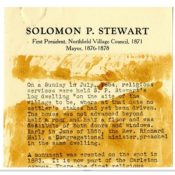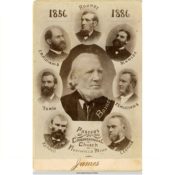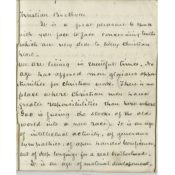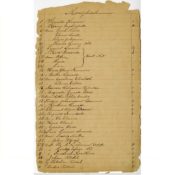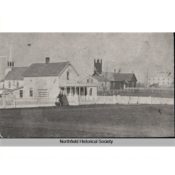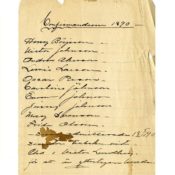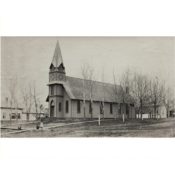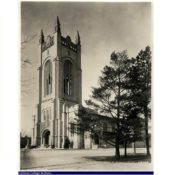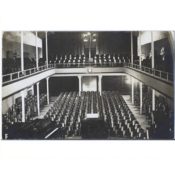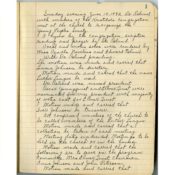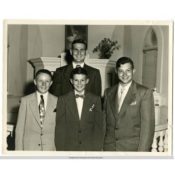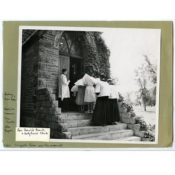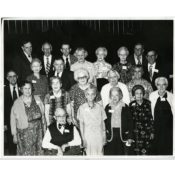
By Stephanie Hess, Northfield-Rice County Digital History Collection, January 2019
Like many towns in Minnesota, Northfield has been the home of several churches. Most formed around groups of people with a shared background. Churches in the Northfield area are both spiritual and social communities. They also preserve the past by keeping records on members and life events.
Christianity first came to Minnesota with missionaries starting in 1680. Nearly two hundred years later, Henry B. Whipple was elected the first Episcopal Bishop of Minnesota. He moved to Rice County in 1859 to serve the area’s new settlers.
The first minister to preach in Northfield was the Reverend Richard Hall. He led a worship service in June of 1855. The next year, town founder John North helped organize Northfield’s first Congregational Church.
Two more churches began in 1856: The Methodist Episcopal Church and the First Baptist Church. These churches formed before they had buildings. Their members were mostly settlers from New England.
Separate immigrant groups formed their own churches. For example, German immigrants built a Methodist Church in 1856 and a Moravian Church in 1869. The Norwegians founded St. John’s Lutheran Church in 1869. The first Swedish immigrants in Rice County formed Christdala Church in 1877.
Irish and German Catholics worshipped together at St. Dominic’s Roman Catholic Church starting in 1860. The Danes formed St. Peter’s Lutheran Church in 1893. A second Norwegian group founded Bethel Lutheran Church in 1908. These churches held services in their original languages into the 20th century.
Area churches helped create Northfield’s two colleges. The General Conference of the Congregational Churches of Minnesota wanted to start a college somewhere in the young state. Members of Northfield’s Congregational Church offered twenty acres of land so that it would be built here. Others promised to pay over $21,000. The Conference agreed and formed Northfield College in 1866. This college became Carleton College.
A group of Norwegian Lutherans also started a religious school for their youth. This school, called St. Olaf’s School, opened on January 8, 1875. It became St. Olaf College in 1889. Many members of St. John’s Lutheran Church were also administrators and teachers at St. Olaf College.
All of the churches in the Northfield area provided spiritual guidance and places of worship. They also planned social gatherings, educated their youth, provided financial support, and shared cultural traditions. Women and children served their community through special church groups.
Although most churches in the Northfield area are Christian, other world religions are beginning to appear. Both colleges have also provided religious opportunities for students who practice Judaism, Islam, Hinduism, and Buddhism.
Over the years, ceremonies held at these churches helped people celebrate special occasions. Through church history, we can learn many things about the growth of the Northfield community.
Primary Sources
Discussion Questions
When you look at the individual items in the Northfield-Rice County Digital History Collection, use the zoom-in tool to view details in the images or more easily read the documents. Use the tab labeled “TEXT” to read full transcriptions of the documents.
Questions
- What significant life events are noted and or celebrated at churches? Can you see examples in the sources above?
- Why did early Northfield settlers found churches very soon after arriving to the area? What benefits would churches bring to this new community?
- Compare the photographs of the different church buildings in Northfield above. How do they look alike? How are they different? Why do they look the way they do?
- What can documents like membership lists (i.e. St. John’s, Congregational) and confirmation lists (i.e. Christdala) tell us about the people who attended these churches?
- Why were the youth of Northfield encouraged to attend Sunday School and join youth groups for Bible study and community gatherings – like Christdala’s Luther League?
- How do area churches address the needs and wants of their communities? What other community groups can offer similar services?
- Why did the churches formed by immigrant groups hold services in Swedish, Norwegian, German, etc., rather than English? Why do you think they stopped speaking those languages in the 20th century?
- While St. Olaf College still identifies as a Lutheran church college, Carleton is no longer associated with any formal religious group. Why do you think this is the case? What are the pros and cons of church affiliation for these colleges?
- How are today’s churches similar to those that formed in the 1800s? How are they different?
- What can you learn about Northfield people, the values of the town, and the role of religion in the identity of those who lived here from studying church history?
Related Items in the Northfield-Rice County Digital History Collection
Centennial Anniversary Celebration, 1856-1956, of the First Congregational Church and First Baptist Church in Northfield
Christdala Swedish Lutheran Church collection
Christdala Swedish Lutheran Church membership register
Christdala Swedish Lutheran Church minutes and records, 1877-1941
Church Certificates and Forms for Christdala Members
Congregational Church bulletins, 1917-1919
Congregational Church records: Book 1 (1856-1885) and Book 2 (1885-1908)
Directory of the Episcopal Church in Dundas and Northfield
First United Church of Christ collection (formerly Congregational Church)
History of Bethel Lutheran Free Church
History of Church of the Holy Cross
History of Four Northfield Churches
History of Pastors of the Congregational and Baptist Churches
A History of the Northfield and Dundas Churches
A History of the Swedish Evangelical Lutheran Christdala Congregation
Holy Cross Church in Dundas collection
Looking Backward: A History of the Congregational Church in Northfield
Methodist Church in Northfield
Problems, Policies, and Progress scrapbook of the First United Church of Christ
St. John’s Lutheran Church collection
St. John’s Lutheran Church Ladies’ Aid materials
St. John’s Lutheran Church membership book
St. John’s Norwegian Lutheran Church: A Record of the First Fifty Years, 1869-1919
St. John’s: History and the Present
Seventy-five Years at St. John’s: 1869-1944
Additional Resources
Chapman, Richard M. “Religious Belief and Behavior.” In Minnesota in a Century of Change: the State and its People Since 1900, edited by Clifford Clark, 507-538. St. Paul: Minnesota Historical Society Press, 1989.
Clark, Clifford E., Jr., ed. Minnesota in a Century of Change: The State and Its People Since 1900. St. Paul: Minnesota Historical Society Press, 1989.
Harvey, Thomas. “Small-Town Minnesota.” In Minnesota in a Century of Change: the State and its People Since 1900, edited by Clifford Clark, 99-127. St. Paul: Minnesota Historical Society Press, 1989.
Hong, Edna. The Book of a Century: The Centennial History of St. John’s Lutheran Church, Northfield, Minnesota. Northfield, MN: St. John’s Lutheran Church, 1969. Available online (accessed June 26, 2018).
Our Story: A Guide to the History of Northfield Minnesota. Northfield, MN: Northfield Historical Society Press, 2013.
Rossinow, Doug. “Tradition, Schism, and Continuity in Minnesota’s Communities of Faith.” MNopedia, Minnesota Historical Society. Web (accessed June 5, 2018).
Zellie, Carole. “Historic Resources.” In Northfield: The History and Architecture of a Community, produced by Northfield Heritage Preservation Commission. Northfield, MN: Northfield Printing, 1999.
Primary Source Analysis
Here are some tips for analyzing the primary sources found above and throughout the DHC. For each source, ask students to indicate:
- the author’s point of view
- the author’s purpose
- historical context
- audience
For inquiry-based learning, ask students to:
- explain how a source tells its story and/or makes its argument
- explain the relationships between sources
- compare and contrast sources in terms of point of view and method
- support conclusions and interpretations with evidence
- identify questions for further investigation
Additional Tools
- Document Analysis Worksheets from the National Archives
- Teaching with Primary Sources Videos and Sets from the Minnesota Historical Society
- Using Primary Sources from the Library of Congress
Minnesota Education Standards
Here is a list of education standard codes for benchmarks that can be explored using this Primary Source Set.
- 0.4.1.2.1
- 1.4.1.2.1, 1.4.1.2.2, 1.4.2.4.1
- 2.4.1.1.1, 2.4.1.2.1, 2.4.2.4.2
- 3.4.1.2.1
- 4.4.2.4.1
- 5.4.1.2.1
- 6.4.1.2.1, 6.4.4.20.2, 6.4.4.23.1, 9.4.4.23.3
- 7.4.1.2.1
- 9.4.1.2.1, 9.4.4.18.4
- 1.8.7.7
- 2.8.7.7
- 3.2.7.7, 3.6.2.2, 3.6.7.7, 3.6.8.8, 3.8.2.2, 3.8.7.7, 3.8.8.8
- 4.2.7.7, 4.6.2.2, 4.6.7.7, 4.6.8.8, 4.8.2.2, 4.8.7.7, 4.8.8.8
- 5.2.7.7, 5.6.2.2, 5.6.7.7, 5.6.8.8, 5.8.2.2, 5.8.7.7, 5.8.8.8
- 6.12.1.1, 6.12.2.2, 6.12.4.4, 6.12.7.7, 6.12.9.9, 6.14.2.2, 6.14.7.7, 6.14.8.8
- 9.12.1.1, 9.12.2.2, 9.12.4.4, 9.12.7.7, 9.12.9.9, 9.14.2.2, 9.14.7.7, 9.14.8.8
- 11.12.1.1, 11.12.2.2, 11.12.4.4, 11.12.7.7, 11.12.9.9, 11.14.2.2, 11.14.7.7, 11.14.8.8
Send us feedback about this primary source set.
This publication was made possible in part by the people of Minnesota through a grant funded by an appropriation to the Minnesota Historical Society from the Minnesota Arts and Cultural Heritage Fund. Any views, findings, opinions, conclusions or recommendations expressed in this publication are those of the authors and do not necessarily represent those of the State of Minnesota, the Minnesota Historical Society, or the Minnesota Historic Resources Advisory Committee.

